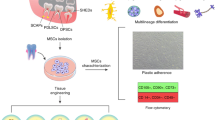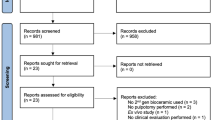Key Points
-
Highlights the shortcomings of current restorative materials and the subsequent drive to develop new dental materials which induce regeneration of lost tissue.
-
Presents evidence-based research on the physical, mechanical, chemical and biological properties of a 'new regenerative' calcium-based material.
-
Discusses the clinical indications of a novel dental material within general practice.
Abstract
As part of the continuing evolution towards conservative dentistry there has been a drive to push further and investigate the possibility of inducing the repair and regeneration of lost dental hard tissue. Until recently, the prospect of repair and regeneration had been confined to laboratory studies and hypothesised scientific models. In 2009, a new product was launched claiming to be a revolutionary material capable of offering a bioactive and biocompatible replacement for dentine. The calcium-based cement is reported to preserve pulp vitality, promote pulp healing and provide a natural substitute for dentine through bioactive stimulation of the dentino-pulpal complex. Its clinical indications are extensive, described as a restorative material suitable for use wherever dentine replacement is required. In this article the physical, mechanical, chemical and biological properties of this novel material are presented, together with the results of experimental laboratory-based investigations and on-going clinical in vivo investigations.
Similar content being viewed by others
Log in or create a free account to read this content
Gain free access to this article, as well as selected content from this journal and more on nature.com
or
References
Emerging trends in (bio)material research; Repair or regeneration, a short review. In Goldberg M (ed) Biocompatibility or cytotoxic effects of dental composites. Chapter VI-1. Working group of ORE-FDI. Oxfordshire: Coxmoor Publishing Co, 2009.
Laurent P, Aubut V, About I . Biological properties; Development of a bioactive Ca3SiO5 based posterior restorative material (Biodentine™). In Goldberg M (ed) Biocompatibility or cytotoxic effects of dental composites. Chapter VI-2-2-1. Working group of ORE-FDI. Oxfordshire: Coxmoor Publishing Co, 2009.
Torabinejad M, Hong C U, Mc Donald F, Pitt Ford T R . Physical and chemical properties of a new root-end filling material. J Endod 1995; 21: 349–353
Camilleri J, Montessin F E, Brady K, Sweeney R, Curtis R V, Pitt Ford T R . The constitution of mineral trioxide aggregate. Dent Mater 2005; 21: 297–303
Pitt Ford T R, Torabinejad M, Abedi H . Using MTA as a pulp capping material. J Am Dent Assoc 1996; 127: 1491–1494
Research and development department Septodont, Biodentine™; Active Biosilicate Technology™. Internal data; scientific file, 2009.
Laurent P, Camps J, De Méo M, Déjou J, About I . Induction of specific cell responses to a Ca3SiO5-based posterior restorative material. Dent Mater 2008; 24: 1486–1494
Koubi G, Franquin J C, Colon P . A clinical study of a new Ca3SiO5-based material indicated as a dentine substitute. Abstract in Clin Oral Invest 2009 and poster Consuero 2009 Seville, Spain March 12th-14th 2009.
Pradelle-Plasse N, Tran X V, Colon P . Physico-chemical properties. In Goldberg M (ed) Biocompatibility or cytotoxic effects of dental composites. Chapter VI-2-1. Working group of ORE-FDI. Oxfordshire: Coxmoor Publishing Co, 2009.
Dental materials and their selection. O'Brien W (ed). 4th ed. Ed Quintessence Publishing Company, 2008.
Santos A D, Moraes J C, Araujo E B, Yukimitu K, Valerio Filho W V . Physico-chemical properties of MTA and a novel experimental cement. Int Endod J 2005; 38: 443–447
Déjou J, Raskin A, Colombani J, About I . Physical, chemical and mechanical behaviour of a new material for direct posterior fillings. Eur Cell Mater 2005; 10: 22
Tran V, Pradelle N, Colon P . Microleakage of a new restorative calcium based cement (Biodentine®). Oral Presentation PEF IADR 2008.
Koubi S, Elmerini H, Koubi G, Tassery H, Camps J . Quantitative evaluation by glucose diffusion of microleakage in aged calcium silicate based open sandwich restorations. Int J Dent 2012; DOI: 10.1155/2012/105863.
Boinon C, Bottero-Cornillac M J, Koubi G, Déjou J . Evaluation of adhesion between composite resins and an experimental mineral restorative material. Euro Cell Mater 2007; 13: 17.
Quote from Professor T Watson . The French Revolution. The Dentist 2010; 26: 73–72.
Boukpessi T, Septier D, Goldberg M . Animal Studies. In Goldberg M (ed) Biocompatibility or cytotoxic effects of dental composites. Working group of ORE-FDI. Oxfordshire: Coxmoor Publishing Co, 2009.
Laurent P, Camps J, About I . Biodentine™ induces TGF- β1 release from human pulp cells and early dental pulp mineralisation. Int Endod J 2011; DOI:10/1111/j.1365-2591.2011.01995.x.
Han L, Okiji T . Uptake of calcium and silicon released from calcium silicate based endodontic materials into root canal dentine. Int Endod J 2011; DOI:10.1111/j.1365-2591.2011.01924.x
About I, Raskin A, De Meo M, Déjou J . Cytotoxicity and Genotoxicity of a new material for direct posterior fillings. Euro Cell Mater 2005; 10: 23
Biodentine™; Active Biosilicate Technology™. Product Information Leaflet 2009. Septodont, Saint Maur Des Fossés, France.
Shayegan A. Etude no PC08–001. Etude de RD94 comme agen pulpaire dans le cadre de pulpotomie et coiffage direct sur les dents lactéales de cochon. Report RD RA DEV 94–006.
Han L, Okiji T . Uptake of calcium and silicon released from calcium silicate-based endodontic materials into root canal dentine. Int Endod J 2011; 44: 1081–1087.
About I, Raskin A, De Meo M, Déjou J . Cytotoxicity and genotoxicity of a new material for direct restorative posterior fillings. Eur Cell Mater 2005; 10: 23.
Machtou P. Open trial, not randomised study evaluating the efficacy and the tolerance of RD94 in patients needing endodontic care, medical device class III. 2009a 09/001.
About I, Bottero M J, de Denato P, Camps J, Franquin J C, Mitsiadis T A . Human dentin production in vitro. Exp Cell Res 2000; 258: 33–41.
Boukpessi T, Décup F, Septier D, Chaussain-Miller C, Goldberg M. RD94 In indirect pulp-capping situation induces reactionary dentin formation. IADR-CED congress in Munich, Germany, 2009.
Acknowledgements
The authors would like to state that there is no affiliation between themselves and with the manufacturer (Septodont, Saint Maur Des Fossés, France) of this product.
Author information
Authors and Affiliations
Corresponding author
Additional information
Refereed paper
Rights and permissions
About this article
Cite this article
Bachoo, I., Seymour, D. & Brunton, P. A biocompatible and bioactive replacement for dentine: is this a reality? The properties and uses of a novel calcium-based cement. Br Dent J 214, E5 (2013). https://doi.org/10.1038/sj.bdj.2013.57
Accepted:
Published:
Issue date:
DOI: https://doi.org/10.1038/sj.bdj.2013.57
This article is cited by
-
Effects of different surface treatment methods on the micro-shear bond strength of calcium silicate–based materials
Journal of the Australian Ceramic Society (2023)
-
Comparative evaluation of shear bond strength of calcium silicate-based liners to resin-modified glass ionomer cement in resin composite restorations - a systematic review and meta-analysis
Evidence-Based Dentistry (2022)
-
The effect of the maturation time of calcium silicate-based cement (Biodentine™) on resin bonding: an in vitro study
Applied Adhesion Science (2019)
-
Clinical case reports using a novel calcium-based cement
British Dental Journal (2013)



